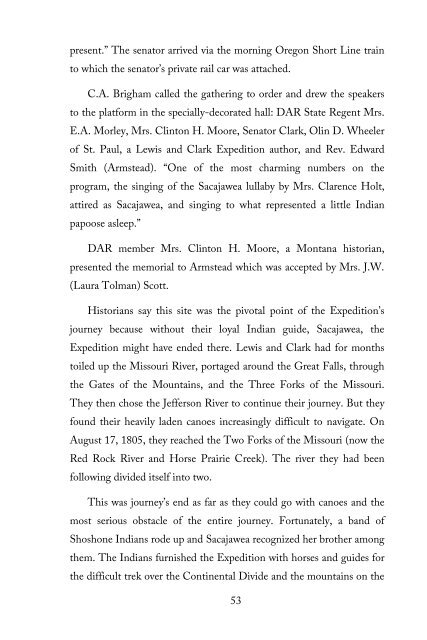Montana's DAR Markers . . . Honoring Where History Was Made
This book is a 200-page thank you to the women of Montana State Society Daughters of the American Revolution for their work in placing historical markers across the state of Montana. Starting in 1908, Montana DAR has installed 70 historical markers across the state. Of those, 33 remain. This book records why the markers’ sites were selected, their history, and the backstory of each.
This book is a 200-page thank you to the women of Montana State Society Daughters of the American Revolution for their work in placing historical markers across the state of Montana. Starting in 1908, Montana DAR has installed 70 historical markers across the state. Of those, 33 remain. This book records why the markers’ sites were selected, their history, and the backstory of each.
Create successful ePaper yourself
Turn your PDF publications into a flip-book with our unique Google optimized e-Paper software.
present.” The senator arrived via the morning Oregon Short Line train<br />
to which the senator’s private rail car was attached.<br />
C.A. Brigham called the gathering to order and drew the speakers<br />
to the platform in the specially-decorated hall: <strong>DAR</strong> State Regent Mrs.<br />
E.A. Morley, Mrs. Clinton H. Moore, Senator Clark, Olin D. Wheeler<br />
of St. Paul, a Lewis and Clark Expedition author, and Rev. Edward<br />
Smith (Armstead). “One of the most charming numbers on the<br />
program, the singing of the Sacajawea lullaby by Mrs. Clarence Holt,<br />
attired as Sacajawea, and singing to what represented a little Indian<br />
papoose asleep.”<br />
<strong>DAR</strong> member Mrs. Clinton H. Moore, a Montana historian,<br />
presented the memorial to Armstead which was accepted by Mrs. J.W.<br />
(Laura Tolman) Scott.<br />
Historians say this site was the pivotal point of the Expedition’s<br />
journey because without their loyal Indian guide, Sacajawea, the<br />
Expedition might have ended there. Lewis and Clark had for months<br />
toiled up the Missouri River, portaged around the Great Falls, through<br />
the Gates of the Mountains, and the Three Forks of the Missouri.<br />
They then chose the Jefferson River to continue their journey. But they<br />
found their heavily laden canoes increasingly difficult to navigate. On<br />
August 17, 1805, they reached the Two Forks of the Missouri (now the<br />
Red Rock River and Horse Prairie Creek). The river they had been<br />
following divided itself into two.<br />
This was journey’s end as far as they could go with canoes and the<br />
most serious obstacle of the entire journey. Fortunately, a band of<br />
Shoshone Indians rode up and Sacajawea recognized her brother among<br />
them. The Indians furnished the Expedition with horses and guides for<br />
the difficult trek over the Continental Divide and the mountains on the<br />
53





